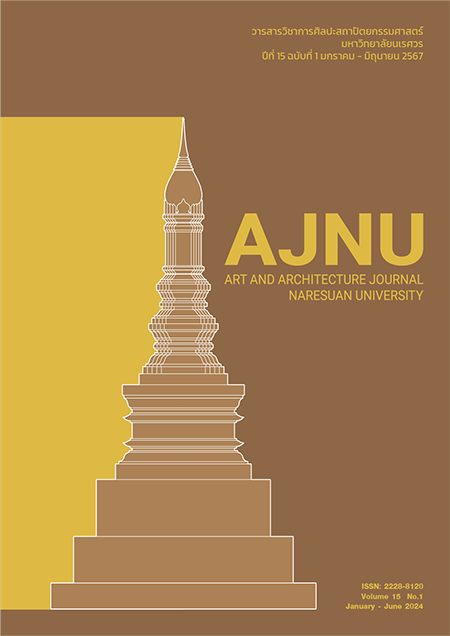Design of interior design stencil patterns according to Pathum Thani province’s identity
Main Article Content
Abstract
The objective of this research is to study the identity of Pathum Thani province in order to design and develop the perforated design for interior design stencil patterns that reflect the identity of Pathum Thani province, as well as to study satisfaction with the design of the patterns. The study process consists of the following steps: study of the identity of Pathum Thani province from documentary sources, study of distinctive identity and design concepts for decorative patterns through survey data collected from 400 individuals in the Pathum Thani province area as a guide for creative design and development of the perforated patterns, evaluation of the perforated pattern designs through interviews with a group of 10 representatives from local community enterprises and 10 representatives from government agencies, and evaluation of satisfaction with the decorative patterns by 400 individuals in the Pathum Thani province area. The study results indicate that Pathum Thani province has the most distinctive identity in four categories, namely: lotus and rice sheaves as symbols of its geographic location, swan as a religious symbol, bullet wood pattern on Mon scarf as a symbol of social culture, and Mon-style dance as a symbol of performing arts. The decorative perforated plate patterns for interior design that people in Pathum Thani province are most satisfied with is the one that combines 2 pattern styles: a design that shows the interwoven sub-patterns of lotus and bullet wood, and a design that tells a story by incorporating all 4 distinctive identity symbols of the province. The composition is arranged in a curved line pattern inspired by Mon dance movements, with a prominent large lotus flower paired with rice stalks, lotus leaves, and a swan, emphasizing easy recognition and memorable symbolism. Based on the satisfaction evaluation of the pattern design, it was found that the highest level of satisfaction was in the practical use for home decoration, with a high level of satisfaction ( = 4.22) and a standard deviation (S.D. = 0.78).The highest level of satisfaction for beauty was also found, with a high level of satisfaction ( = 4.17) and a standard deviation (S.D. = 0.75).The highest level of satisfaction for value and communication in the appropriate value for decoration was also found to be high ( = 4.17) with a standard deviation (S.D. = 0.73)
Article Details

This work is licensed under a Creative Commons Attribution-NonCommercial-NoDerivatives 4.0 International License.
References
กิดานันท์ มะลิทอง. (2536). เทคโนโลยีการศึกษาร่วมสมัย. กรุงเทพฯ : สำนักพิมพ์เอดิสันเพรสโปรดักส์.
กำจร สุนพงษ์ศรี. (2555). สุนทรียศาสตร์หลักปรัชญาศิลปะ ทฤษฎีทัศนศิลป์ ศิลปะวิจารณ์ (พิมพ์ครั้งที่ 1).
กรุงเทพฯ: สำนักพิมพ์จุฬาลงกรณ์มหาวิทยาลัย.
ชูศักดิ์ ไทพาณิชย์. (2556). การออกแบบลวดลาย. กรุงเทพฯ : สำนักพิมพ์วาดศิลป์.
ดุสิตธร งามยิ่ง. (2559). รำมอญ: ประเพณีทรงคุณค่าจังหวัดปทุมธานี. วารสารวไลยอลงกรณ์ปริทัศน์, 6(2), 55-66.
ประเสริฐ ศีลรัตนา. (2538). การออกแบบลวดลาย. กรุงเทพฯ : สำนักพิมพ์โอเดียนสโตร์.
มาริสา หิรัญตียะกุล และนพดล ตั้งสกุล. (2565). การศึกษาอัตลักษณ์ถิ่นที่ในสิ่งแวดล้อมสรรค์สร้าง. วารสารวิจัยและสาระ
สถาปัตยกรรมและการผังเมือง, 19(1), 99-113.
สำนักงานจังหวัดปทุมธานี.(18 ตุลาคม 2562). แผนพัฒนาจังหวัดปทุมธานี. สืบค้นเมื่อ 5 ตุลาคม 2563, จาก
http://www.pathumthani.go.th/new_web/webplan/index.html
สำนักงานประชาสัมพันธ์จังหวัดปทุมธานี. (4 กันยายน 2564). พาณิชย์จังหวัดปทุมธานีเปิดตัวต้นแบบผลิตภัณฑ์นวัตกรรม
เชิงพาณิชย์สู่ตลาดสากล. สืบค้นเมื่อ 10 ตุลาคม 2564, จาก https://www.innnews.co.th/news/news-
general/news_182431/
สุชาติ เถาทอง. (2539). หลักการทัศนศิลป์ (พิมพ์ครั้งที่ 3). กรุงเทพฯ : สำนักพิมพ์นำอักษรการพิมพ์.
องค์การบริหารส่วนจังหวัดปทุมธานี. (2552). ความเป็นมาของท้องถิ่น (พิมพ์ครั้งที่ 1). กรุงเทพฯ : ทริปเพิ้ล กรุ๊ป.
อภิญญา เฟื่องฟูสกุล. (2546). อัตลักษณ์ (พิมพ์ครั้งที่ 1). กรุงเทพฯ: คณะกรรมการสภาวิจัยแห่งชาติ.
Edward Relph . (1976). Place and Placelessness. London : Pion Limited.
Lois Fichner Rathus. (1985). Understanding Art. New Jersey : Prentice-Hell, Englewood Cliffs.


